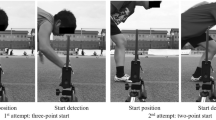Abstract
The purpose of this study is to determine the suitability of grouping ages in comparing the physical fitness performance among 13- to 17-year-old male and female athletic athletes during the talent identification process. A total of 178 males [mean (±SD) age 14.3 (±1.2) years; weight 55.7 (±11.8) kg; and height 166.0 (±6.8) cm] and 214 females [mean (±SD) age 14.5 (±1.3) years; weight 49.5 (±10.4) kg; and height 157.2 (±5.9) cm] young healthy athletic athletes from 12 different States’ Sports School across Malaysia participated in this study. Subjects performed seven selected fitness testing; 40 m sprint, vertical jump, standing broad jump, medicine ball throw, max push-up, 1 min sit-up, and yo-yo endurance level 1 test. Statistical analyses used were a one-way ANOVA with Tukey’s post hoc tests, with p < 0.05 denoting significance. No significant differences were found in all fitness components, except explosive power for male athletic athletes aged 13 and 14 years and female athletic athletes aged 13, 14, 15, 16, and 17 years. No significant differences were also found between 15-, 16-, and 17-year-old male athletic athletes in all fitness component variables. However, there is a significant difference between the lower and upper tiers of age groups in various fitness components. Combination of data between ages into one group between ages (13- and 14-year-olds), (15-, 16-, and 17-year-olds), and (14- and 15-year-olds) for future data analysis regarding physical fitness component can be done. Muscular endurance component is robust and not influenced by age group differences. These differences may be caused by differences in physical fitness maturity rate in which female athletes mature at an early age compared to male athletes.
Access this chapter
Tax calculation will be finalised at checkout
Purchases are for personal use only
Similar content being viewed by others
References
Chuman K, Hoshikawa Y, Iida I, Nishijima T (2011) Relationships between Yo-Yo intermittent recovery tests and development of aerobic and anaerobic fitness in U-13 and U-17 soccer players. Int J Sport Health Sci 1–16
Cumming SP, Searlea C, Hemsleya JK, Haswella F, Edwardsa H, Scottb S, Grossb A, Ryanc D, Lewise J, Whited P, Caind A, Mitchella SB, Malinaf RM (2018) Biological maturation, relative age and self-regulation in male professional academy soccer players: a test of the underdog hypothesis. Psychol Sport Exerc 39:147–153
Cunha GDH, Vaz MA, Geremia JM, Leites GT, Baptista RR, Lopes AL, Oliveira AR (2016) Maturity status does not exert effects on aerobic fitness in soccer players after appropriate normalization for body size. Pediatr Exerc Sci 28(3):456–465
Figueiredo AJ, Gonçalves CE, Silva CMJ (2009) Youth soccer players, 11–14 years: maturity, size, function, skill and goal orientation. Ann Hum Biol 36(1):60–73
Gabbett T, Georgieff B (2006) The development of a standardized skill assessment for junior volleyball players. Int J Sports Physiol Perform 1:95–107
Gabbett T, Georgieff B, Domrow N (2007) The use of physiological, anthropometric, and skill data to predict selection in a talent-identified junior volleyball squad. J Sports Sci 25(12):1337–1344
Gould D, Carson S (2008) Life skills development through sport: current status and future directions. Int Rev Sport Exerc Psychol 1(1):58–78
Hoffmann A, Wulff J (2015) Talent identification and development in Germany: state of play and current tasks. In: Andersen S, Houlihan B, Ronglan LT (eds) Managing elite sport systems; research and practice. Routledge, London
Honer O, Schultz F, Schreiner R, Votteler A (2015) Prognostic validity of motor diagnostic in the German talent identification development program. Int Res Sci Soccer II:267–276
Jamaluddin MNF, Miswan MS, Fauzi SSM, Gining RAJ, Raman NF, Ghazali MZM (2019) Sports suitability prediction based on physical fitness components using k-nearest neighbors algorithm. In: Kor LK, Ahmad AR, Idrus Z, Mansur K (eds) Proceeding of the third international conference on computing, mathematics and statistics (iCMS2017). Springer, Singapore, pp 11–17
Krasilshchikov O (2013) Talent Identification and development: reassessing the principle model. Acta Fac Educ Phys Univ Comenianae 53(1):25–33
Leger L, Mercier D, Gadoury C (1988) The multistage 20-meter shuttle run test for aerobic fitness. J Sport Sci 6:93–101
Malina RM, Silva CEM, Figueiredo AJ (2013) Growth and maturity status of youth players. In: Williams AM (ed) Science and soccer: developing elite performers, 3rd edn. Routledge, Abington, UK, pp 307–332
Miswan MS, Wilson NC (2010) Physical characteristics and fitness of Malaysian junior basketball players. ISN Bull 3(4):31–38
Rasid SMM, Abdullah MR, Juahir H, Maliki ABHM, Musa RM, Kosni NA, Hashim MR, Eswaramoorthi V, Najmi N (2019) Determining youth profile using principle component analysis for identifying talent in sports. Int J Recent Technol Eng (IJRTE) 8:212–215
Schuiling KD, Likis FE (2016) Women’s gynecologic health. Jones & Bartlett Learning. Burlington, MA, p 22
Vänttinen T, Blomqvist M, Nyman K, Häkkinen K (2011) Changes in body composition, hormonal status, and physical fitness in 11-, 13-, and 15-year-old finnish regional youth soccer players during a two-year follow-up. J Strength Conditioning Res Nat Strength Conditioning Assoc 25(12):3342–3351
Williams C (1988) A progressive shuttle run test to estimate maximal oxygen uptake. Br J Sport Med 22:141–144
Author information
Authors and Affiliations
Corresponding author
Editor information
Editors and Affiliations
Rights and permissions
Copyright information
© 2020 Springer Nature Singapore Pte Ltd.
About this paper
Cite this paper
Miswan, M.S., Mohd Aznan, E.A., Ismail, A.D., Md Japilus, S.J., Mohd Ghazali, M.Z.b. (2020). Determination Suitability in Comparing Selected Physical Fitness Components among Young Athletes between Age Groups and Gender during Talent Identification Process in Malaysia. In: Kaur, N., Ahmad, M. (eds) Charting a Sustainable Future of ASEAN in Business and Social Sciences. Springer, Singapore. https://doi.org/10.1007/978-981-15-3859-9_6
Download citation
DOI: https://doi.org/10.1007/978-981-15-3859-9_6
Published:
Publisher Name: Springer, Singapore
Print ISBN: 978-981-15-3858-2
Online ISBN: 978-981-15-3859-9
eBook Packages: Business and ManagementBusiness and Management (R0)




